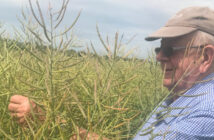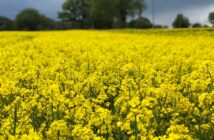The AICC has detected significant levels of Verticillium wilt on varieties at its trial sites in Suffolk and Sussex. The infection scores provide a graphic illustration of the different resistance levels between varieties, while varying yield levels demonstrate that the impact on performance is complicated.
AICC agronomist Peter Cowlrick of CCC Ltd, who managed the trials, says 2016 has undoubtedly been a high pressure year with the trial confirming what many growers are reporting on their farms.
“The season has generally been less than favourable to oilseed rape. Many crops went in late, and in to wet and compacted seedbeds, while the mild winter did nothing to arrest disease development. It is under such situations when we tend to see the most obvious effects of Verticillium wilt,” says Peter Cowlrick.
Principal symptoms are grey striping on the plant stems, while maturity occurs several weeks earlier than normal on affected side branches. Come harvest the plant is clearly dead, while the stems of uninfected plants would still be green.
The trial has been running for several years and despite deliberately choosing high pressure sites, conditions have not always been suitable to generate meaningful data.
“In a low pressure season its effects are not always obvious. The crop is able to tolerate infection when conditions are good and the plant has access to sufficient moisture and nutrients, but under stress, and we have seen plenty of that with light leaf spot and flea beetle, then the crop can suffer greatly.
“My view of it is that it makes the plant less physiologically robust. It places the plant under duress, to the extent that it is less able to cope with the infection to the point that the infection is able to physiologically override the crop.” says Peter Cowlrick.
The 2015 season was also good for Verticillium wilt with yield reductions of up to 20% were recorded. Along with this season’s results the AICC now has sufficiently robust data to inform its members on variety selection.
“For some time we have cautioned against choosing varieties which have been found to display more than 30% infection in the weeks before harvest. Of the 30 varieties in trial this season, 13 were found to be displaying infection above this level.”
The variety with the lowest level of infection was Barbados, a KWS variety added to the North Recommended List this year, with less than 10% infection. By coincidence, the variety with the highest level of infection was also a KWS variety, Quartz, added to the Recommended List in 2013, with an infection of almost 70%.
“Barbados showed strong resistance and was among the higher yielding varieties. Flamingo at 4.95t/ha also looks promising while Incentive at 5t/ha performed admirably. We still have much to learn about this disease, but it is clear that when conditions suit, it is a disease that’s impact can be severe,” says Peter Cowlrick.



